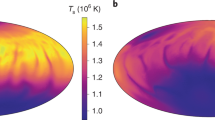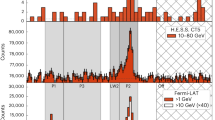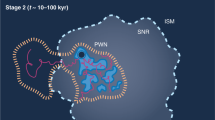Abstract
Neutron stars are a common compact endpoint of the life of stars. Magnetized and rotating neutron stars emit beams of radiation, which can only be seen when the observer and the beam stand aligned. Periodic recurrence of such alignment gives rise to pulsations and to the name ‘pulsar’ for the star itself. We present a physical model for the non-thermal emission of pulsars. With just four physical parameters, we fit the spectra of the γ- and X-ray pulsars across seven orders of magnitude in energy. We find that all detections can be encompassed in a continuous variation of the model parameters. The model explains the appearance of sub-exponential cutoffs at high energies as a natural consequence of synchro-curvature-dominated losses, unveiling that curvature-only emission plays a less significant role—if any—in the spectrum of most pulsars. The model also explains the flattening of the X-ray spectra at soft energies as a result of propagating particles being subject to synchrotron losses all along their trajectories. Using this model, we analyse how observations in γ-rays can predict the detectability of the pulsar in X-rays, and vice versa.
This is a preview of subscription content, access via your institution
Access options
Access Nature and 54 other Nature Portfolio journals
Get Nature+, our best-value online-access subscription
$29.99 / 30 days
cancel any time
Subscribe to this journal
Receive 12 digital issues and online access to articles
$119.00 per year
only $9.92 per issue
Buy this article
- Purchase on Springer Link
- Instant access to full article PDF
Prices may be subject to local taxes which are calculated during checkout





Similar content being viewed by others
References
Atwood, W. B. et al. The Large Area Telescope on the Fermi Gamma-ray Space Telescope mission. Astrophys. J. 697, 1071–1102 (2009).
Abdo, A. A. et al. The second Fermi Large Area Telescope catalog of gamma-ray pulsars. Astrophys. J. Suppl. 208, 17 (2013).
Kuiper, L. & Hermsen, W. The soft γ-ray pulsar population: a high-energy overview. Mon. Not. R. Astron. Soc. 449, 3827–3866 (2015).
Ackermann, M. et al. An extremely bright gamma-ray pulsar in the Large Magellanic Cloud. Science 350, 801–805 (2015).
Kuiper, L. & Dekker, A. The Fermi LAT/GBM detection of pulsed gamma-ray emission from PSR J1846-0258 up to 100 MeV. The Astronomer’s Telegram 9077 (2016).
Kuiper, L., Hermsen, W. & Dekker, A. The Fermi LAT detection of magnetar-like pulsar PSR J1846-0258 at high-energy gamma-rays: a genuine MeV pulsar like PSR B1509-58. Preprint at https://arxiv.org/abs/1709.00899 (2017).
Cheng, K. S., Ho, C. & Ruderman, M. Energetic radiation from rapidly spinning pulsars. I—Outer magnetosphere gaps. II—VELA and Crab. Astrophys. J. 300, 500–539 (1986).
Cheng, K. S., Ho, C. & Ruderman, M. Energetic radiation from rapidly spinning pulsars. II. VELA and Crab. Astrophys. J. 300, 522 (1986).
Romani, R. W. Gamma-ray pulsars: radiation processes in the outer magnetosphere. Astrophys. J. 470, 469 (1996).
Zhang, L. & Cheng, K. S. High-energy radiation from rapidly spinning pulsars with thick outer gaps. Astrophys. J. 487, 370 (1997).
Hirotani, K. & Shibata, S. One-dimensional electric field structure of an outer gap accelerator—I. Gamma-ray production resulting from curvature radiation. Mon. Not. R. Astron. Soc. 308, 54–66 (1999).
Muslimov, A. G. & Harding, A. K. Extended acceleration in slot gaps and pulsar high-energy emission. Astrophys. J. 588, 430–440 (2003).
Dyks, J. & Rudak, B. Two-pole caustic model for high-energy light curves of pulsars. Astrophys. J. 598, 1201–1206 (2003).
Kalapotharakos, C., Harding, A. K., Kazanas, D. & Contopoulos, I. Gamma-ray light curves from pulsar magnetospheres with finite conductivity. Astrophys. J. Lett. 754, L1 (2012).
Philippov, A. A. & Spitkovsky, A. Ab-initio pulsar magnetosphere: particle acceleration in oblique rotators and high-energy emission modeling. Preprint at https://arxiv.org/abs/1707.04323 (2017).
Kalapotharakos, C., Harding, A. K., Kazanas, D. & Brambilla, G. Fermi gamma-ray pulsars: understanding the high-energy emission from dissipative magnetospheres. Astrophys. J. 842, 80 (2017).
Hirotani, K. Three-dimensional non-vacuum pulsar outer-gap model: localized acceleration electric field in the higher altitudes. Astrophys. J. Lett. 798, L40 (2015).
Takata, J. & Cheng, K. S. X-Ray/GeV emissions from Crab-like pulsars in the LMC. Astrophys. J. 834, 4 (2017).
Viganò, D., Torres, D. F., Hirotani, K. & Pessah, M. E. An assessment of the pulsar outer gap model—I. Assumptions, uncertainties, and implications on the gap size and the accelerating field. Mon. Not. R. Astron. Soc. 447, 2631–2648 (2015).
Viganò, D., Torres, D. F., Hirotani, K. & Pessah, M. E. An assessment of the pulsar outer gap model—II. Implications for the predicted γ-ray spectra. Mon. Not. R. Astron. Soc. 447, 2649–2657 (2015).
Viganò, D. & Torres, D. F. Modelling of the γ-ray pulsed spectra of Geminga, Crab, and Vela with synchro-curvature radiation. Mon. Not. R. Astron. Soc. 449, 3755–3765 (2015).
Viganò, D., Torres, D. F. & Martín, J. A systematic synchro-curvature modelling of pulsar γ-ray spectra unveils hidden trends. Mon. Not. R. Astron. Soc. 453, 2599–2621 (2015).
Cheng, K. S. & Zhang, J. L. General radiation formulae for a relativistic charged particle moving in curved magnetic field lines: the synchrocurvature radiation mechanism. Astrophys. J. 463, 271 (1996).
Viganò, D., Torres, D. F., Hirotani, K. & Pessah, M. E. Compact formulae, dynamics and radiation of charged particles under synchro-curvature losses. Mon. Not. R. Astron. Soc. 447, 1164–1172 (2015).
Chiang, J. & Romani, R. W. An outer gap model of high-energy emission from rotation-powered pulsars. Astrophys. J. 436, 754–761 (1994).
McCann, A. A stacked analysis of 115 pulsars observed by the FERMI LAT. Astrophys. J. 804, 86 (2015).
Wang, Y., Takata, J. & Cheng, K. S. Mechanism of the X-ray and soft gamma-ray emissions from high magnetic field pulsar: PSR B1509-58. Astrophys. J. 764, 51 (2013).
Wang, Y., Ng, C. W., Takata, J., Leung, G. C. K. & Cheng, K. S. Emission mechanism of GeV-quiet soft gamma-ray pulsars: a case for peculiar geometry? Mon. Not. R. Astron. Soc. 445, 604–613 (2014).
Harrison, F. A. et al. The Nuclear Spectroscopic Telescope Array (NuSTAR) high-energy X-ray mission. Astrophys. J. 770, 103 (2013).
Tatischeff, V. et al. The e-ASTROGAM gamma-ray space mission. Preprint at https://arxiv.org/abs/1608.03739 (2016).
Moiseev, A. A. et al. Compton-Pair Production Space Telescope (ComPair) for MeV gamma-ray astronomy. Preprint at https://arxiv.org/abs/1508.07349 (2015).
Zhang, S. N. et al. eXTP—Enhanced X-ray Timing and Polarization Mission. Preprint at https://arxiv.org/abs/1607.08823 (2016).
Barcons, X. et al. Athena (Advanced Telescope for High ENergy Astrophysics) assessment study report for ESA Cosmic Vision 2015–2025. Preprint at https://arxiv.org/abs/1207.2745 (2012).
Takata, J., Shibata, S., Hirotani, K. & Chang, H.-K. A two-dimensional electrodynamical outer gap model for γ-ray pulsars: γ-ray spectrum. Mon. Not. R. Astron. Soc. 366, 1310–1328 (2006).
Avni, Y. Energy spectra of X-ray clusters of galaxies. Astrophys. J. 210, 642–646 (1976).
Lampton, M., Margon, B. & Bowyer, S. Parameter estimation in X-ray astronomy. Astrophys. J. 208, 177–190 (1976).
Li, J. et al. Observing and modelling the gamma-ray emission from pulsar/pulsar wind nebula complex PSR J0205+6449/3C 58. In 7th Int. Fermi Symp. 012 (2017).
Abdo, A. A. et al. The vela pulsar: results from the first year of Fermi LAT observations. Astrophys. J. 713, 154–165 (2010).
Pilia, M., Treves, A., Pellizzoni, A., Trois, A. & Motta, S. Observation of gamma-ray emission from PSR J2022+3842. The Astronomer’s Telegram 3466 (2011).
Ohuchi, H., Arimoto, M., Yatsu, Y., Nakamori, T. & Kawai, N. Does PSR J2022+3842 emit gamma rays? 6th Fermi Symposium 2015 3246 (2015).
Smith, D. >200 Gamma-ray pulsars with the Fermi satellite. In MODE Meeting: Pulsars and Their Environments. (Paris Observatory, 2016); http://mode.obspm.fr/pdf/Smith.pdf
Acero, F. et al. Fermi Large Area Telescope third source catalog. Astrophys. J. Suppl. 218, 23 (2015).
Pilia, M. et al. AGILE observations of the “Soft” gamma-ray pulsar PSR B1509-58. Astrophys. J. 723, 707–712 (2010).
Abdo, A. A. et al. Detection of the energetic pulsar PSR B1509-58 and its pulsar wind nebula in MSH 15-52 using the Fermi-Large Area Telescope. Astrophys. J. 714, 927–936 (2010).
Torres, D. F. et al. Time-dependent modeling of TeV-detected, young pulsar wind nebulae. J. High Energy Astrophys. 1, 31–62 (2014).
Chen, G. et al. NuSTAR observations of the young, energetic radio pulsar PSR B1509-58. Astrophys. J. 817, 93 (2016).
Ackermann, M. et al. An extremely bright gamma-ray pulsar in the Large Magellanic Cloud. Science 350, 801–805 (2015).
Lande, J. et al. Search for spatially extended Fermi Large Area Telescope sources using two years of data. Astrophys. J. 756, 5 (2012).
Press, W. H., Teukolsky, S. A., Vetterling, W. T. & Flannery, B. P. Numerical Recipes in FORTRAN. The Art of Scientific Computing. 2nd edn, (Cambridge Univ. Press, Cambridge, 1992).
Li, J., Torres, D. F., de Oña Wilhelmi, E., Rea, N. & Martin, J. Gamma-ray emission from PSR J0007+7303 using seven years of Fermi Large Area Telescope observations. Astrophys. J. 831, 19 (2016).
Roberts, M. S. E., Romani, R. W. & Johnston, S. Multiwavelength studies of PSR J1420-6048, a young pulsar in the Kookaburra. Astrophys. J. Lett. 561, L187–L190 (2001).
Pancrazi, B. et al. X-ray follow-up observations of the two γ-ray pulsars PSR J1459-6053 and PSR J1614-2230. Astron. Astrophys. 544, A108 (2012).
Hessels, J. W. T. et al. Observations of PSR J2021+3651 and its X-ray pulsar wind nebula G75.2+0.1. Astrophys. J. 612, 389–397 (2004).
McGowan, K. E. et al. XMM-Newton observations of PSR B1706-44. Astrophys. J. 600, 343–350 (2004).
Mignani, R. P. et al. VLT and Suzaku observations of the Fermi pulsar PSR J1028-5819. Astron. Astrophys. 543, A130 (2012).
Klingler, N. et al. Chandra observations of outflows from PSR J1509-5850. Astrophys. J. 828, 70 (2016).
Gotthelf, E. V. & Bogdanov, S. NuSTAR hard X-ray observations of the energetic millisecond pulsars PSR B1821-24, PSR B1937+21, and PSR J0218 + 4232. Astrophys. J. 845, 159 (2017).
Acknowledgements
The author acknowledges support from grants AYA2015-71042-P and SGR 2014–1073, as well as the Centres de Recerca de Catalunya Programme of the Generalitat de Catalunya and Chinese Academy of Sciences grant 11473027. The author is grateful to L. Kuiper, H. An, D. Smith and J. Li for providing observational data, and to J. Li, A. Papitto, J. Pons and D. Viganò for comments.
Author information
Authors and Affiliations
Contributions
D.F.T. carried out all the work relating to this manuscript.
Corresponding author
Ethics declarations
Competing interests
The author declares no competing financial interests.
Additional information
Publisher’s note: Springer Nature remains neutral with regard to jurisdictional claims in published maps and institutional affiliations.
Supplementary information
Supplementary Information
Supplementary Tables 1–2, Supplementary Figures 1–7.
Rights and permissions
About this article
Cite this article
Torres, D.F. Order parameters for the high-energy spectra of pulsars. Nat Astron 2, 247–256 (2018). https://doi.org/10.1038/s41550-018-0384-5
Received:
Accepted:
Published:
Issue Date:
DOI: https://doi.org/10.1038/s41550-018-0384-5
This article is cited by
-
MeV astrophysical spectroscopic surveyor (MASS): a compton telescope mission concept
Experimental Astronomy (2024)
-
Optical and ultraviolet pulsed emission from an accreting millisecond pulsar
Nature Astronomy (2021)



